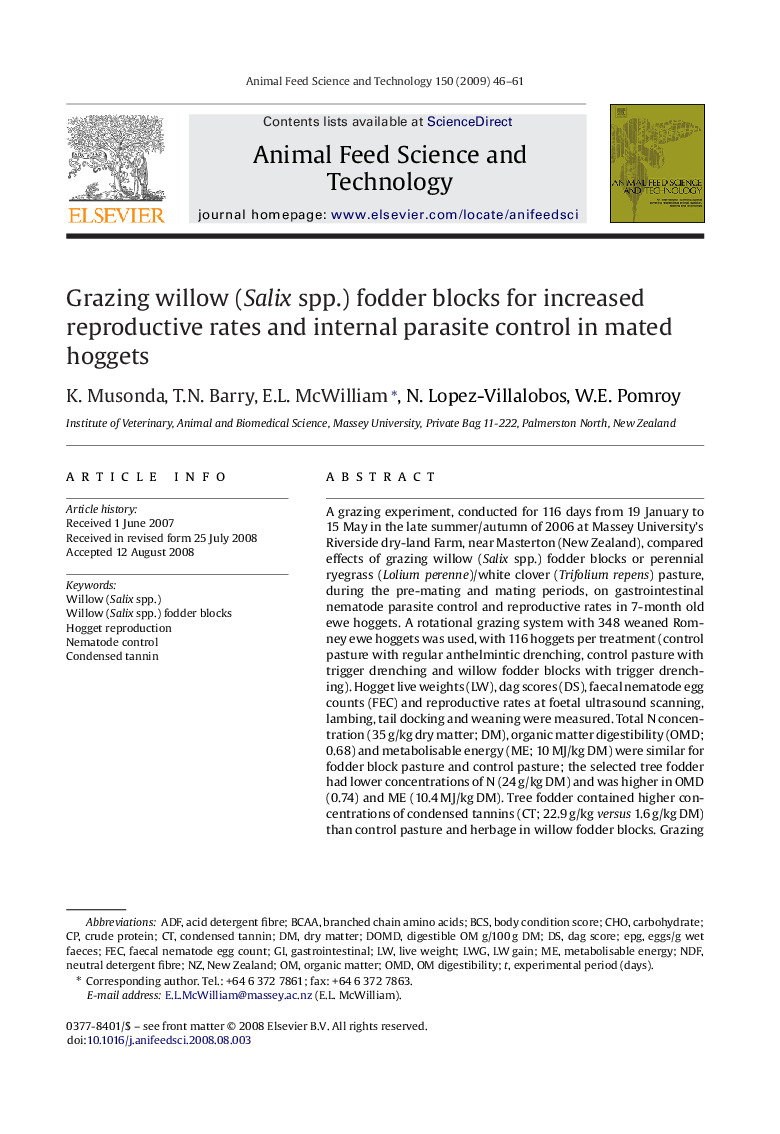| کد مقاله | کد نشریه | سال انتشار | مقاله انگلیسی | نسخه تمام متن |
|---|---|---|---|---|
| 2420503 | 1552460 | 2009 | 16 صفحه PDF | دانلود رایگان |

A grazing experiment, conducted for 116 days from 19 January to 15 May in the late summer/autumn of 2006 at Massey University's Riverside dry-land Farm, near Masterton (New Zealand), compared effects of grazing willow (Salix spp.) fodder blocks or perennial ryegrass (Lolium perenne)/white clover (Trifolium repens) pasture, during the pre-mating and mating periods, on gastrointestinal nematode parasite control and reproductive rates in 7-month old ewe hoggets. A rotational grazing system with 348 weaned Romney ewe hoggets was used, with 116 hoggets per treatment (control pasture with regular anthelmintic drenching, control pasture with trigger drenching and willow fodder blocks with trigger drenching). Hogget live weights (LW), dag scores (DS), faecal nematode egg counts (FEC) and reproductive rates at foetal ultrasound scanning, lambing, tail docking and weaning were measured. Total N concentration (35 g/kg dry matter; DM), organic matter digestibility (OMD; 0.68) and metabolisable energy (ME; 10 MJ/kg DM) were similar for fodder block pasture and control pasture; the selected tree fodder had lower concentrations of N (24 g/kg DM) and was higher in OMD (0.74) and ME (10.4 MJ/kg DM). Tree fodder contained higher concentrations of condensed tannins (CT; 22.9 g/kg versus 1.6 g/kg DM) than control pasture and herbage in willow fodder blocks. Grazing willow fodder blocks increased LW gain (approximately 97 g/day versus 86 g/day) and increased reproductive rate corrected to equal LW by approximately 17 lambs/100 hoggets mated, due to increases in both oestrus activity and conception rates (hoggets pregnant/100 mated). Calculated daily DM (1.41 kg) and ME (14 MJ) intakes were similar in all groups. Calculated daily CT intake (6.0 g versus 2.1 g) and CT intake/100 g CP intake (2.2 g versus 0.7 g) were higher for willow fodder block hoggets than for the control pasture groups, and this may have increased the flow of undegraded dietary protein to the small intestine leading to increases in reproductive rates of this group. Grazing willow fodder blocks failed to reduce the number of anthelmintic drenches (3) needed to maintain FEC below 1000 eggs/g wet faeces, but was successful in reducing DS compared to grazing conventional ryegrass/white clover pastures. Grazing willow fodder blocks can be beneficial in sustainable farming systems since tree fodder can sustain growth rates, increase reproductive rates and reduce dag formation in parasitized hoggets.
Journal: Animal Feed Science and Technology - Volume 150, Issues 1–2, 30 March 2009, Pages 46–61